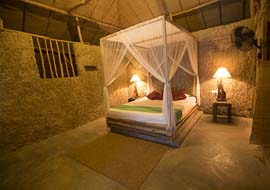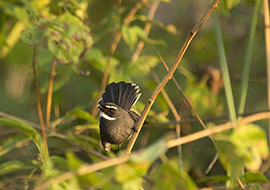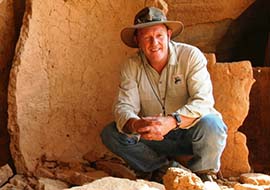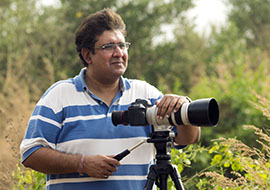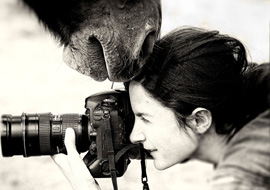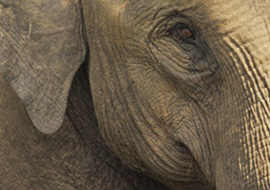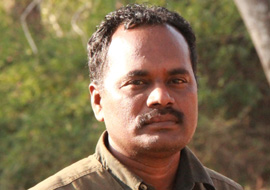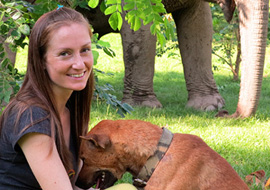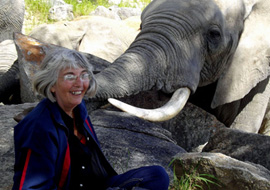Graduated from Delhi College of Arts in the 70’s, he initially started working as a graphic designer and later as a creative director for some of the leading advertising agencies. He had once visited the Valley of Flowers in Garhwal Himalayas and the visit changed his life entirely. Dushyant was saddened by the unchecked damage being done to this nature’s wonderful treasure, by the pilgrims to the nearby Hemkund shrine, tourists and local sheep and goat herders. For the next three years he visited the Valley regularly to record the extent of abuse and then made a forceful presentation to the Ministry of Environment, asking for its protection. As a result of his tireless campaign, finally the Valley of Flowers was declared a ‘National Park’ in 1982 and is now a World Heritage Site.
A hard-core environmentalist, adventurer, explorer, nature & wildlife photographer and writer, he also has his own pictorial books and regularly contributes pictures and articles to various publications. He has travelled and trekked extensively in Assam, Arunachal Pradesh, Ladakh, Uttarakhand and Thar - the Indian desert. As a nature & wildlife photographer, he has always tried to highlight environmental concerns, particularly in the Himalayan region.
In 2003 he received Sir Edmund Hillary’s ‘Himalayan Environment Trust Award for valuable contribution to the cause of Himalayan environment’. It was given personally to him by Sir Edmund Hillary on the fiftieth anniversary of Mount Everest’s maiden climb. In October-November 2010 he went on a Brahmaputra River Expedition as one of the five member 'core team' that did this first ever descend of the world’s highest river from source-to-the-sea through Tibet-India-Bangladesh. It was a two month long, 2,800 km journey on the river done in inflatable boats.
When not travelling to remote places, he spends his time between Sat Tal and Noida photographing birds, animals, insects and other miracles of nature. Among his best known images is the much acclaimed and awarded picture of a charging rhino shot in Kaziranga. Perhaps the only one ever taken that shows the dramatic act, head-on.
He now largely ‘shoots to share’ and has a fan-following of nearly 5,000 friends on Facebook.
The Wild Walk is deeply inspired to even talk to him about his passion and the nature of his work and he is one of India’s Conservation Warrior.
- Shrilekha Venkateswar | The Wild Walk

Tell us something about your life, your journey and how it all began? How did you first get into photography?
I studied applied art at Delhi College of Art and passed out in1972. Initially I worked as a graphic designer for some design studios and later became a creative director and worked in that capacity for some of the leading advertising agencies during the seventies. On the surface all was well. It was a glamorous life, money was good and I couldn’t have asked for anything more. But I knew this was a part of the journey but not my station in life. In 1978 I gave up, what was then termed as a brilliant career, packed a back-pack and set out in search, without knowing what! The next two years took me from Geeling to Gadra Road and Nubra valley to Nagarcoil, in the four corners of India and a whole lot in between.
It was during these wanderings that I walked into the Valley of Flowers in Garhwal Himalayas for the first time in my life. It made me sad to see that this paradise was not protected. Pilgrims, tourists and shepherds were inflicting unchecked damage to one of the finest show window of nature that opened its doors for a brief period during the summer and monsoon months. I decided to do something about it and for two years photographed the damage being done in the absence of any regulation. Armed with my slides and an old projector, I walked into the ministry of environment to ask for protection for the Valley of Flowers. Fortunately the then Minister of state for environment, C.P.N. Singh was very receptive and had been to the Valley during his School days. He shared my concern and listened to my suggestions which I had figured out at ground zero itself. What transpired in that long meeting and visual presentation finally resulted in the Valley of Flowers being declared as a national Park in 1982. Today it is a World Heritage site. The Valley got its protection and I found my purpose.
I figured that photography was a powerful tool of communication and could be used with great effect to create awareness, which is the first step towards any meaningful conservation effort.
 What made you get passionate over Wildlife Photography?
What made you get passionate over Wildlife Photography?
During my travels in the late seventies, once when I was passing through Assam, I decided to visit Kaziranga National Park - my first ever exposure to a wildlife area. I have described the experience in the Introduction of my forthcoming book on Kaziranga and I am quoting few lines from the book.
“It was a misty winter morning when I entered Kaziranga for the first time. Sitting on an elephant going through grass taller than my mount, with visibility barely a few metres, the chances of seeing any life in the wild looked very remote. And that’s when it happened.
Like a miracle, the veil of fog was drawn away and what appeared before me was a beautiful landscape complete with a lake, patches of wooded forest, and grasslands that stretched for miles before melting into the distant haze. Across the lake, dozens of swamp deer were grazing on fresh grass shoots. Under the watchful eye of a massive dominant male, a large herd of wild buffalos was lazing in a loosely formed circle around the young ones. It seemed like another world-too peaceful to be real, in these times. My mind drifted, visualizing that there was a time, not so long ago, when the whole world must have been like this. Peaceful, serene, and complete in its balance, supporting all interdependent forms of life. That was before man started interfering with nature, exploiting natural resources that he had no means to replace, in the name of ‘need’ and development. The other aspect of human behaviour that spelled disaster was his misplaced ego. A desire to establish and display supremacy over all other fellow beings with whom he shared this earth. He set about domesticating animals that could provide him muscle power and hunting down those who were powerful but refused to submit to his dictates. He seems to have derived a sadistic pleasure in the display of his cunning hunting skills, against which the noble denizens of the wild were no match. The result is there for everybody to see. Countless varieties of fauna and flora have been lost due to direct human intervention.
I was recalled to the present by faint sounds of rhythmic ripples. Slowly from the still waters of the shallow lake rose the Unicornis-the great Indian one-horned rhinoceros. Water splashed all around as he heaved his bulk towards the shore. Fully covered with mud, this prehistoric-looking first citizen of the rhinoland walked lazily towards us and I took my ‘first picture’ of Kaziranga”.
 Who or what inspires you to do what you do and why?
Who or what inspires you to do what you do and why?
My father was, and will always remain my greatest inspiration. He taught me that we must discover the best in us and continue to explore till we do. I am a student of nature and will remain so all my life. Nature has taught me that life never ends because all existence is interlinked. Unfortunately man has yet to learn that environment is not his property, it is his inheritance for safekeeping for the next generation. In nature, for those who fail to respect the laws of survival there is a provision of extinction; and humans are no exception to that rule.
How do you think Photography can change People’s attitude towards few wildlife or certain endangered species?
You can’t think of protecting what you are not aware and photography can make you aware what you might lose, if you don’t wake-up.
What do you consider your greatest achievement?
I sincerely hope it is yet to come and may all that I have done so far pales in the face of it.
Could you share some of your most favourite wildlife images tell us the story behind it?
Just a few days back I had an important visitor at my house in sattal. The WORLD’S LARGEST MOTH - Atlas Moth (Attacus atlas) - in beauty and grandeur it towers over any butterfly!
With wingspan ranging from 25cm to 30cm (10 to 12 inches) Atlas moth has the largest wing surface area among all insects of the world. It is believed that it gets its name from the map like pattern on its wings. In Hongkong its Cantonese name translates to ‘Snake’s head moth’ with obvious reference to very distinct snake-like shape and pattern of its wing tips. They are found in the tropical and sub-tropical forests of South-East Asia. Considering that India is the western most country where they can be seen, hills of Uttarakhand must be the western most geographical limit of their range.
Do you have a tip for beginner to intermediate photographers that will help them improve their photography?
Everybody sees all that is visible. A photographer isolates the picture and leaves out the rest!
 What do you think the young generation possess in terms of wildlife conservation which your generation did not possess and what is that young generation do not possess which yours possessed. How do you think it will affect wildlife?
What do you think the young generation possess in terms of wildlife conservation which your generation did not possess and what is that young generation do not possess which yours possessed. How do you think it will affect wildlife?
The most important change has been the information technology. Today the access to information has become a great asset for awareness and action for wildlife conservation. Instances get reported fast, and action can be mobilized a lot faster than before. Take the recent case of Amur falcons, the longest travelling raptors in the world, who pass through Nagaland by the millions every year and were being killed by the thousands by local tribes. Posts on social media focused the attention on the problem. Following the revelations the authorities acted swiftly and introduced a wide range of measures to implement and enforce legislation to protect the Amur Falcons. An armed Forest Protection Force was immediately deployed that seized nets and released any captured live falcons. The Force now patrols the area every year during the migration time to prevent the practice of trapping the birds. The Nagaland Forest Department, supported by NGOs has led an awareness-raising campaign holding meetings with community and religious leaders, as well as open public meetings. Such things were not possible earlier in such a short time.
What the young generation lacks today is perhaps the dedication of the stalwarts. I would like to see more Salim Ali’s, Bittu Sehgal’s, Vivek Menon’s and Bikram Grewal’s to emerge from the new generation of conservationists.
Wildlife photography has become a pest mostly. What do you have to say for the photographers?
As a wildlife photographer for over thirty years I must say that I have seen much more than I have photographed and I have no regrets. I may have missed many a great pictures but I have enjoyed all those wonderful moments. The photographers should look at the larger picture of environment and the freedom of wildlife to live undisturbed, rather than the pictures they capture by being obsessive and intrusive.
What are your biggest fear for this world? Considering most of the areas are exploited by men?
All development is at the cost of environment in one way or the other. The pace of consumerism, development, industrialisation and building construction today far exceeds the nature’s capacity to recover and regenerate resources. We are slipping into environmental-deficit-times. The inter-relation of man and nature has reached a critical state. For any species that is a recipe for doom. Humans are no exception to that rule.
Can you share some of the very tragic incidents that have happened in the recent past which causes reasons for concern?
In the past few months a number of leopard deaths have come to light in the NCR region. Areas surrounding the capital of India used to have pockets of rich forests till recently. Illegal stone and sand mining, encroachment of forest land for urbanisation and vehicular traffic on forest roads have contributed to the depletion of leopard habitat. Its high time that we declare their areas as protected sanctuaries if we want to save these beautiful cats.
Dadri wet-land, a marshy landscape near Noida used to be a great habitat for many water birds including Sarus cranes-the tallest of all flying birds. Lately their habitat has shrunk due to encroachment and so have their numbers. It’s a sad thing that once abundant, these beautiful birds have now become a rare sighting.
Saddest thing of recent times have been the decline in the population of House sparrows. Like domestic dogs, sparrows have always lived close to humans only. These world’s most widely distributed birds are finding it difficult to survive with changing architecture that leaves no space for them to nest, extensive use of pesticide that poisons insects-primary source of nourishment for their young ones and cell phone radiation that disturbs hatching of their eggs, to name just a few reasons. It would be a sad thing if this childhood friend of ours will one day disappear from our midst.
 What are your future plans?
What are your future plans?
I take life as it comes and don’t make too many plans. Presently I am shooting for the pictorial content for my next book on Corbett National Park.
I feel Kashmir has remained underexposed from the point of view of wildlife and particularly bird life. I wish to have an opportunity to shoot and show that to the world one day.
What would be your message to the entire world?
Survival of both, humans and wildlife is linked to our forests. The rate at which our forests are disappearing is alarming to say the least. If we have to arrest and reverse this trend we’ll have to do some re-thinking in our life styles and consumption patterns. I’ll give you just one example here, how changing lifestyle effects the environment. At least in India, just three generations ago toilet paper was not known as a product. None of our grandparents used any. Today it is a regular item on our urban grocery list. Do you know that toilet paper alone wipes out 27,000 trees from the face of the earth every day!
 You have been active all along on wildlife conservation. Can you briefly tell us where you have set afoot and your publications?
You have been active all along on wildlife conservation. Can you briefly tell us where you have set afoot and your publications?
For the past thirty years I has been a hard-core environmentalist, nature & wildlife photographer and writer. In addition to my own pictorial books, I also regularly contribute pictures and articles to various publications.
I have trekked extensively in Arunachal Predesh, Ladakh, Kumaon, Garhwal and through Thar-the Indian desert. As a nature & wildlife photographer, I have always tried to highlight environmental concerns, particularly in the Himalayan region.
In 2003 I received Sir Edmund Hillary’s ‘Himalayan Environment Trust Award for valuable contribution to the cause of Himalayan environment’.
In October-November 2010, I went on a Brahmaputra River Expedition as one of the five member 'core team' that did this first ever descend of the world’s highest river from source-to-the-sea through Tibet-India-Bangladesh. It was a two month long, 2800 km journey on the river done in three 40hp powered, inflatable boats.
In February 2014, I walked the frozen Zanskar River in Ladakh to photograph the winter landscape, fauna and flora of the region.
I have following pictorial books to my credit:
- N.C. HILLS - The enchanting land and the bird mystery of Jatinga (1994, Konark)
- BHUTAN - A kingdom in the sky (2004, Vikas)
- TEA - Legend, Life and Livelihood of India (2006, LBS-Red River)
- ODISSI - The Dance Divine (2007, Niyogi)
- MANAS - A Pictorial Handbook (2007, LBS-Red River)
- BODOLAND - Back to the Future (2010, LBS-Red River)
- ASSAM - Realm of the Red River (2014, LBS-Red River)
Some of my forthcoming books are:
- KAZIRANGA - Paradise Regained
- CORBETT NATIONAL PARK
- THE ORIGINAL EDEN - Andamans and Nicobar Islands.

